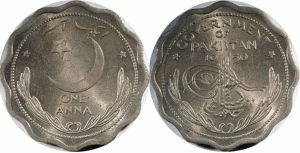

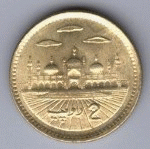

Journey of Pakistani Currency
From "Ana" to Paisa and to Rupee



When Pakistan was carved out of the British India on 14 August 1947, it had no currency notes or coins of its own, nor a central bank or mint to print paper currency or mint coins. In order to cope up with the requirement of the new country, the Governor General of undivided India issued the ‘Pakistan (Monetary System and Reserve Bank) Order, 1947’ on 14 August 1947, the day before partition. Under this order, the Reserve Bank of India was to act as the common currency authority for India and Pakistan until 30 September 1948, allowing a cushion period of almost a year for the newly born state to issue its own currency. As an interim arrangement, the currency notes and coins issued by the Reserve Bank of India and the Government of India were to be the legal tender in Pakistan.
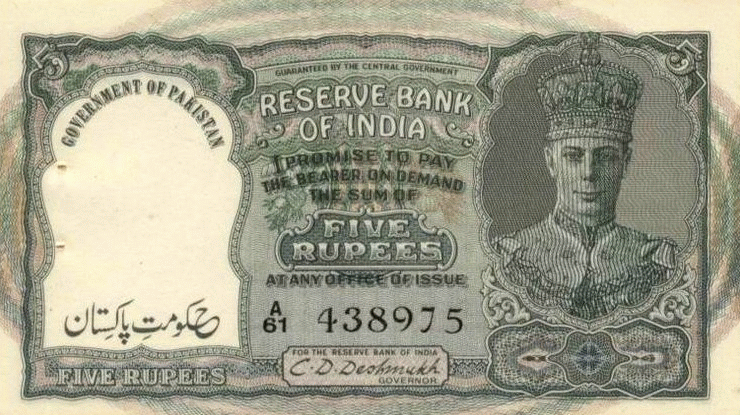
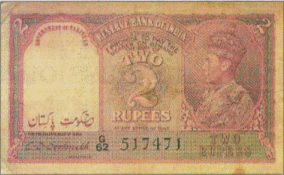
Thus the currency of the Indian Reserve Bank was inscribed with words "Government of Pakistan" both in Urdu and English, and placed into circulation from 1 April 1948 under the responsibility of the Government of Pakistan. So, following a seven-month period where notes of the Reserve Bank of India and the Government of India continued to circulate in Pakistan, modified notes of the Reserve Bank of India in the denominations of 2, 5, 10 and 100 rupees were introduced as planned, along with modified 1-rupee notes of the Government of India. The Indian currency consisted of two inscriptions on the front of the notes: at the top of the white area reserved for viewing the watermark the words "GOVERNMENT OF PAKISTAN" were inscribed in English, while at the bottom of the white area the Urdu rendition of the same phrase appears, i.e. "Hakoomat-e-Pakistan". For these inscriptions, the printing plates were modified, instead of overprints to avoid forgery.

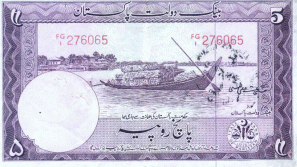
In the meantime, the Pakistan government tasked its Finance Ministry to set up the country's own state bank by 1 July 1948. Despite the scarcity of staff, since most of the non-Muslims workers had left for India and resources, the Pakistani staff took upon themselves it as a challenge to set up the state bank three months in advance of the dead date of September 1948. The government issued the "State Bank of Pakistan Order, 1948" on 12 May 1948 under the authority vested in the Governor General of Pakistan by the provisions of Section 9 of the Indian Independence Act, 1947. Once the State Bank had been established, the efforts intensified to issue Pakistan's own currency much before the given date.

The initial set of bank notes, in the denominations of 5, 10 and 100 rupees, was prepared by Thomas De La Rue & Company of Great Britain. The 5-rupee note was deep blue, the 10-rupee in red, and the 100-rupee note was in rich green colour. To the right, on the front of each note, was a crescent and star in an oval, while to the left the denomination of each note was written in Urdu numerals in a similar oval. The denomination was repeated in Urdu at the bottom centre and in western numerals at the bottom right. On the front of the notes were panels at the bottom with the Urdu words for ‘Government of Pakistan’ repeated in small text. Until 1952 the notes produced for Pakistan had come from a variety of sources. The inscribed notes of the Reserve Bank of India, which were printed at the Government of India’s Security Printing Press at Nasik. The first issue of Rs. 5, 10 and 100-rupee notes was produced by Thomas De La Rue and Company in Great Britain, while the Re. 1- and Rs. 2 notes were produced in Great Britain by Bradbury Wilkinson and Company.
After settling down with the issue of the requisite currency, the next step was the setting up of the first Security Printing Press under the Pakistan Security Printing Corporation at Karachi. The press was owned partially by the British security printing company Thomas De La Rue & Co. Ltd. (40%) and partially by the Government of Pakistan (60%). The paid up capital for the Corporation was 7.5 million rupees. The foundation stone for the new printing works was laid in Karachi by the Muhammad Ali Jinnah, the Governor General of Pakistan, on 11 March 1949.
Till 1960, when Pakistan adopted the metric system, one Pakistani rupee had 16 ana and each ana having 4 paisa, i.e. one rupee having 64 paisas. And as for the coins, there were coins of one, two paisa, one ana, two ana, 4 ana, 8 ana and one rupia (rupee). Thus, one ana was the basic coin (below left two sides of one ana, 2 ana and 8 ana).

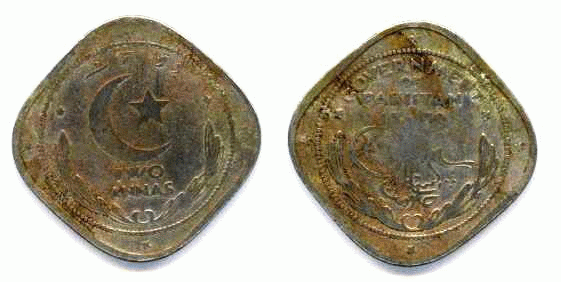
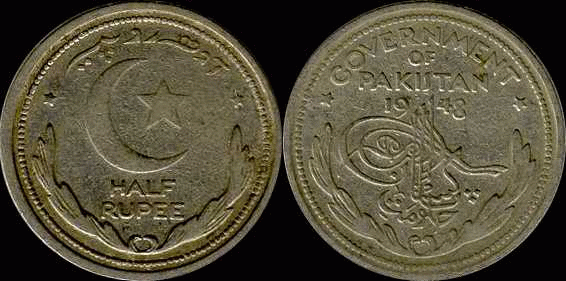
Then in 1960, the country switched to metric system and now one Pakistani rupee had 100 paisa. The coins were of one, two, five, 10, 25, 50 paisa. Later a coin of one rupee was also added. Currency notes of 1,2,5,10,50,100 and 500 have been in use for quite sometime now.
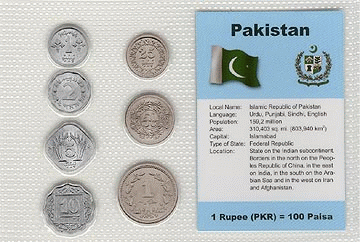
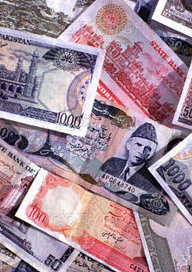
The present currency notes in circulation of Rs.10,50,100 and 500 denominations are as under:
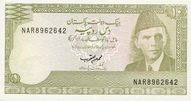



Lately, owing to the diminishing value of the sub divisions of one rupee, not only the currency notes of one, two and five have been replaced with coins, but also all coins of lower than one rupee have ceased to be of any value and are not in circulation anymore. Recently, currency notes of 20 and 5000 have been added to the inventory. These notes have many security features included in these and chances of forgery have almost been made negligible.
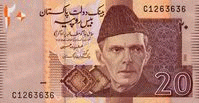

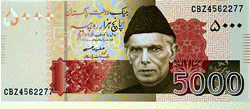

On 10 November State Bank of Pakistan issued new currency notes of 100 and 500 rupees denomination. These notes carry special identification features for the blind and will go a long way to counter the fake currency notes already in circulation in the country. The back of Rs. 100 note sketch of Ziarat Residency where Quaid-e-Azam spent his last days, while Badshahi Mosque of Lahore appears on the back of Rs. 500 note. (photograph courtesy AFP). There was a lot of hue and cry when the State Bank revised the Rs.20/- banknote since it was very similar to the Rs.5000/- since even the literates sometimes got confused and gave away a Rs.5000/- note instead of a Rs.20/- note. Now a new design and colour of Rs. 20 note is in circulation. The Five rupee note has also been reintroduced as it is quite cumbersome to carry a coin of five rupee.
![]() The State Bank of Pakistan has issued new coins of Rs.1 and Rs.2 denomination
with, changed metal composition, colour and weight effective from November 20.
The design of changed metal will be same as of the coins introduced from
September 1998. The existing coins of Rs.1 and Rs.2 in circulation will continue
to be legal tender and remain in circulation. Rs.1 coin will be of aluminum,
white colour with 20 mm diameter having 1.75 grams weight where as Rs.2 coin
will of aluminum white having 22.5 mm diameter with 2.6 gram weight. The new
composition of coins was approved by the Federal Cabinet in its meeting on
January 2007.
The State Bank of Pakistan has issued new coins of Rs.1 and Rs.2 denomination
with, changed metal composition, colour and weight effective from November 20.
The design of changed metal will be same as of the coins introduced from
September 1998. The existing coins of Rs.1 and Rs.2 in circulation will continue
to be legal tender and remain in circulation. Rs.1 coin will be of aluminum,
white colour with 20 mm diameter having 1.75 grams weight where as Rs.2 coin
will of aluminum white having 22.5 mm diameter with 2.6 gram weight. The new
composition of coins was approved by the Federal Cabinet in its meeting on
January 2007.
|
Related Links:
|
Pakistani Currency
Converter | Opening of State
Bank of Pakistan | Official Site: State Bank
of Pakistan | The Pakistani Rupee |
|
|
| HOME PAGE | Copyright©JalalsPages - 2005 - 2008 |